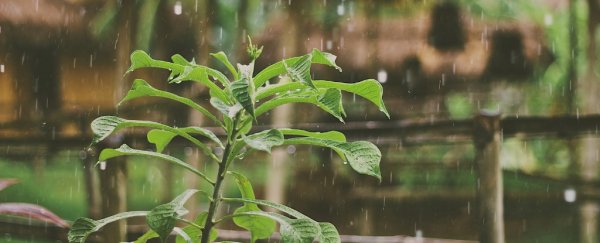Just like us, plants need water to survive, but that doesn't mean these leafy greens enjoy a downpour any more than we do.
When the grey clouds loom and the rain begins to fall, their response is immediate, all-consuming and close to that of 'panic', a surprising discovery reveals.
Strange as that might seem (after all, water is supposed to bring life to plants, not death), experts say moisture is the number one way disease spreads among vegetation, even more so than temperature. The longer a leaf is wet, you see, the greater the chance that a pathogen will set up residence.
"When a raindrop splashes across a leaf, tiny droplets of water ricochet in all directions," says plant biochemist Harvey Millar from The University of Western Australia.
"These droplets can contain bacteria, viruses, or fungal spores. A single droplet can spread these up to 10 metres to surrounding plants."
In other words, a plant's reaction to rain is kind of like your reaction to someone else sneezing on you: it's not pleasant and it sends you straight into defence mode.
Mimicking rain with a spray bottle, an international team of researchers observed a rapid domino-effect of microscopic plant changes, kicked off by a powerful protein called Myc2.
Within the first 10 minutes of water making contact, over 700 genes in the plants responded, and most of these genes continued to increase in expression for about a quarter of an hour, changing the plant's protein, transcription, and hormone balance, before once again returning to normal.
After just a single touch of water, the authors report these plants immediately accumulated signalling compounds such as calcium, activating membrane responses to touch and undergoing genome-wide transcriptional changes.
But while these changes were only momentary, repeated contact eventually led to a plant's stunted growth and delayed flowering.
"When Myc2 is activated, thousands of genes spring into action preparing the plant's defences," Millar explains.
"These warning signals travel from leaf to leaf and induce a range of protective effects."
In total, no less than 20 protein-linked genes were found to be directly targeted and regulated by Myc2 after the water spray. What's more, the same signals these plants were using to spread information amongst their leaves, were also being used to communicate with nearby vegetation.
One of the many chemicals produced in response to their water droplets the authors say, is jasmonic acid, which regulates many physiological processes involved in plant growth and dealing with stress. Plus, when jasmonate chemicals are airborne, they can also let other plants know what's going on and how they are coping.
"If a plant's neighbours have their defence mechanisms turned on, they are less likely to spread disease," Millar explains, "so it's in their best interest for plants to spread the warning to nearby plants."
Protecting yourself as a plant is all about communication, both with yourself and others around you.
Earlier this month, another paper found that when plants are under attack, they evolve a universal 'language' to warn others of dangerous predators.
While rain doesn't bear quite the same death sentence, at times it does come with some serious risks. Hence the panic.
The study was published in PNAS.
